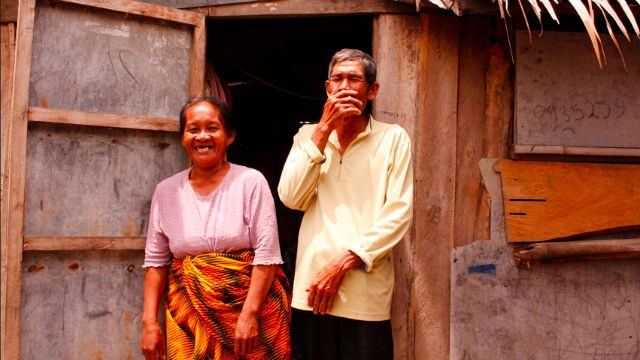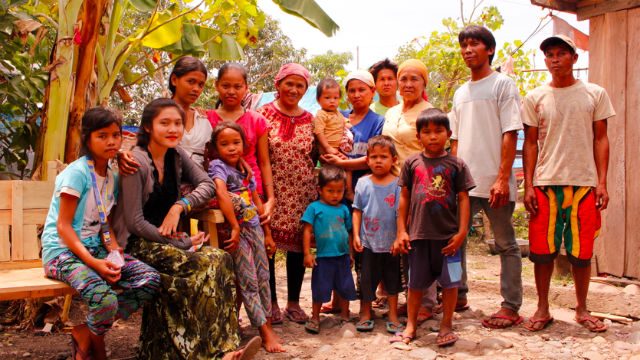SUMMARY
This is AI generated summarization, which may have errors. For context, always refer to the full article.

MAGUINDANAO, Philippines — Sun, soil, and some water. Abdullah Sema likes the simplicity of life as a farmer. The earth is both a source of life and livelihood; it provides everything Sema and his family need.
“We will not grow hungry,” he said gratefully, looking up at the banana trees that surround his home, a structure thrown together by pieces of wood and corrugated steel boarded together to make 4 walls and a roof.
The trees and their giant leaves provide a canopy over their home, which, judging only by size, two people – at most 3 – can sleep in.
His life tilling the soil is evident in his frame that remains long and lean even at the age of 64. Days spent under the sun are carved on his forehead and the deep brown shade of his skin. Even on the warmest of days, he wears long sleeve T-shirts that leave only his weathered hands exposed.
His wife, Ida, called Babuh by everyone else, is a jolly round woman. She has less teeth now but she doesn’t shy away from an occasion to flash her version of a toothy grin.
Life is simple for Sema and his family of 5.
“Wait, we only have 4 kids living with us now,” Sema corrected himself. He still has to get used to the idea of his oldest child now being married and living in a separate home – just a stone’s throw away from his.
Their calm life was disrupted when fighting broke out last January.
“The policemen died,” said Sema.
That was followed by a territorial conflict between the Moro Islamic Liberation Front (MILF) and the Bangsamoro Islamic Freedom Fighters (BIFF).
Still, it was relatively peaceful for awhile.
Then last week, Ida’s sister came running to them for shelter and safety bringing with her, her kids and their kids. Then a brother-in-law came bringing along his family.
Sema can no longer count how many people are now sharing his home. “Maybe around 20 now,” he said, scratching his chin.
Host family
Sema and his wife are known as “host families,” they open up their homes to give shelter to friends and family members who have been displaced.
In Maguindanao, which is riddled by conflict and plagued with annual flooding, displacement comes almost as regularly as the rains.

When Sema’s relatives came knocking, the couple opened their doors to them, the possibility of saying “no” not even crossing their mind.
“It is in Allah’s teachings. We give, we help others without expecting anything in return,” said Sema. “Even if it were complete strangers who came to us for safety, we would not have turned them away.”
“Civilians are forced to flee out of fear. Displacement, especially when it’s prolonged and repeated, uproots people from their normal lives and causes untold suffering,” said Pascal Mauchle, head of the International Committee of the Red Cross (ICRC) delegation in the Philippines.
The lack of proper facilities in evacuation centers, their location being too far away or just the need to be in a secure and familiar environment drive those who are fleeing to seek shelter among relatives and friends as home-based internally displaced persons (IDPs).
The burden placed on a host family sheltering displaced is more difficult to address in a situation of armed conflict where the precarious security and peace situation already make it difficult to track and monitor those who need assistance.
In an evacuation center, the displaced are all grouped together in one place. This makes it easier to assess the basic needs for latrines, water, and health on a per person basis. In a host family, where resources are shared, humanitarian needs are more difficult to ascertain.
Humanitarian non-governmental organizations refer to SPHERE Project, a set of minimum standards for humanitarian response aspects such as shelter, water and sanitation, to make assessments and compute for these basic needs.

Home-based IDPs
Meanwhile, in the Sema home, the young and the old share everything from food to sleeping quarters. They sleep on the floor like sardines. Some sleep on the table in the dirty kitchen and the bench. “We should start a sleeping rotation schedule next so we can sleep in shifts,” joked Sema.
Clumps of bananas hung from the trees, too green to be plucked, eaten or sold, but grown just enough to hold a promise of food on the table and a full stomach that would not have to know the gnarls of hunger pangs.
But that promise is now hanging in the balance as the all-out military offensive against the BIFF goes on its 4th week and with no end in sight.
“We’re getting tired of eating the bananas,” said Sema, managing a weak grin.
“It’s very hard. We have to budget our food. There is not enough space to sleep in and…there is no privacy.”
This is the hardest part, said Sema. A slow smile began to appear on his lips as a wicked glean crept into his eyes.
“There’s no more ‘boxing time’ with the misis!” he laughed, squinting his eyes, and throwing playful air punches.
“Even at this age, I still need that time with the misis. It is only the carabao that gets old!” – Rappler.com
Add a comment
How does this make you feel?





There are no comments yet. Add your comment to start the conversation.